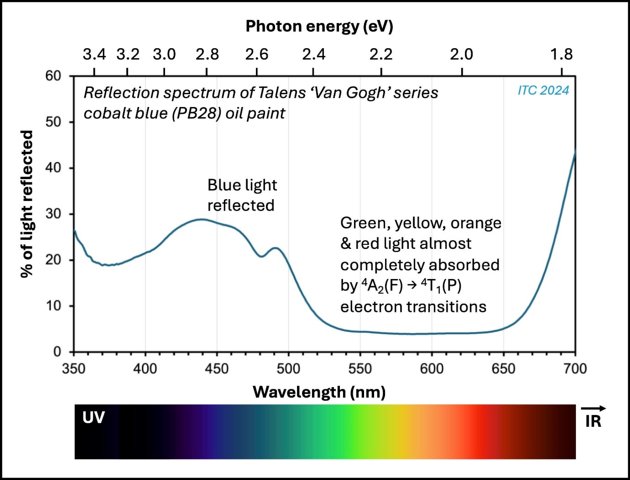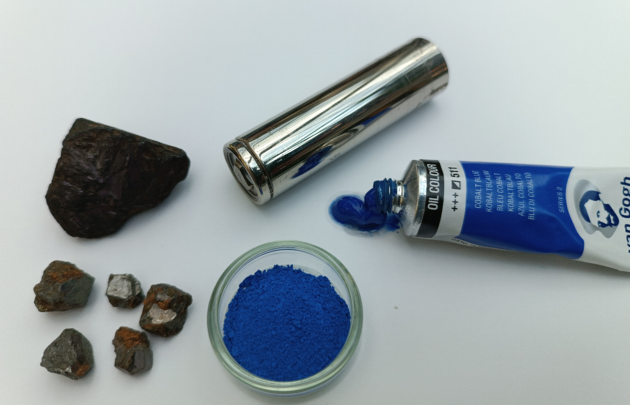Mineral Exploration
Unlocking Earth's Superhot Energy for green and sustainable power generation
3 min
This story is about the colour blue. Like the blue of the skies in Van Gogh’s paintings. But it is also about a critical raw material, cobalt, needed for electric vehicles. And it is about a method that we use to search for raw materials: geological remote sensing. How this is all connected? Read on!
Let me start with my favourite painting in the world: 'Wheatfield with Crows', painted by Vincent van Gogh in 1890. When it’s not on tour to museums around the world, it can be experienced in the Van Gogh Museum in Amsterdam. And experienced it should be; the image on your screen doesn’t do it justice. The size, the composition, but most of all, the colours! For me, it is the blue of the sky that draws me in, lighted from below by those golden hues of the wheatfield.
So what is happening in the paint if we see that deep, intense blue?
It starts with the white light that illuminates the painting. White light is a mixture of many colours. Think of a prism unmixing the light into its different colours. These colours of the light are streams of particles with different energies: the higher energy particles are seen as blue light, the lower energy ones as red light, and all the colours in between. We refer to these particles as photons. When these particles of light hit the pigments in the paint, some are absorbed, while others are not absorbed but reflected and scattered; they may reach our eyes. If we see something as blue, like the blue paint, it means that all the other colours are absorbed by the paint, but not the blue.
But what is the stuff inside the paint that absorbs almost all colours except the blue light? Vincent Van Gogh knew what it was. He wrote to his brother about it: “Cobalt – is a divine colour”.
‘Cobalt blue’ was a paint only discovered in the early 19th century, made by heating alumina with cobalt compounds extracted from cobalt ores. In the 19th century, these ores came mainly from Sweden. This reaction made the compound cobalt aluminate, the pigment in van Gogh’s intense blue paint. When photons hit the cobalt aluminate, electrons in the cobalt atoms can be excited to a higher energy state by completely absorbing a photon. But not any photon; only photons with specific energies (colours) can be absorbed by the electrons in cobalt: the greens, the yellows and the reds, but not the blues. This is because the electrons can only exist at certain energy levels (as explained by quantum physics), so a photon with too much energy, or too little energy, is no good and will not be absorbed.
Below is shown the spectrum of cobalt blue paint as measured in our labs here at ITC, showing how only blue colours are reflected. So blue photons are the ones that can reach our eyes, and we see blue.

Reflectance spectrum of cobalt blue paint as measured in our lab.
Like the blue paint, rocks and minerals have colours that we can see. The processes that give them colour are the same as in the blue paint: atoms with their electrons, but also bonds between atoms, can absorb photons with certain energies and leave others untouched. And these processes also act on photons with ‘colours’ that our eyes cannot see, such as in the infrared part of the spectrum, or in the ultraviolet part. By measuring which colours are present in the spectrum of sunlight that is being reflected by rocks, and working out which ones are missing, we can determine a lot about the rocks’ makeup: which minerals, and sometimes which elements, are present in them.
These measurements are done by spectrometers, which split light in its many constituents and measure their intensities. The state-of-the-art is so-called multi-, or hyperspectral cameras, which record images in which each pixel consists of ten to hundreds of measurements of the intensities of photons with different energies (colours), including in the infrared; not just red, green and blue-like in our eyes or in a regular camera.
These types of cameras can be used in a laboratory such as ours at ITC, but they can also be put on a plane, or drone, or can be mounted on a satellite orbiting the Earth. The analysis of these images that are loaded with spectral information about the rocks on the Earth’s surface is a specialization called ‘geological remote sensing’, researched, and taught at ITC. And one of the key applications of geological remote sensing is in mineral exploration.

Cobalt blue pigment created in our lab, with crystals of cobaltite ore, some modern cobalt blue paint, and a lithium-ion battery cell from a Tesla electric vehicle, containing cobalt.
Exploration for minerals is an important contribution that Earth scientists can make to the global Energy Transition because, for many of the key raw materials needed for zero-carbon technologies, there are issues with the security of supply. And there is one critical raw material for which we really need to step up our exploration efforts: cobalt! The same peculiarities of the electrons in the cobalt atom which allow it to make the brilliant colour that Van Gogh liked so much, also make the element irreplaceable in 21st-century lithium-ion batteries. Batteries for the rapidly expanding fleet of electric vehicles on our roads.
However, currently more than 60% of the world’s supply of cobalt comes from the Democratic Republic of the Congo, where its extraction can be associated with dire environmental impacts, child labour, and local warlord control. So, for a more sustainable and responsible supply of this critical raw material, we need to diversify the source and search for cobalt ores around the globe.
One target that excites geologists and policymakers alike is the waste heaps – so-called tailings - left behind after copper mining. Even in Europe, there are large amounts of tailings from historic mining at times when cobalt was still a useless contaminant in the ore rather than a precious commodity. These tailings can contain up to 100 g of cobalt per ton of waste rock, and remote sensing is already being used to identify the most valuable sites.
At ITC we are convinced that geological remote sensing will be one if the sharpest tools in the exploration geologist's toolbox for decennia to come, including for exploration of Van Gogh’s ‘divine’ material, cobalt.
Interested in learning more? Check out this course on Geological Remote Sensing for Mining and Exploration from Geoversity.